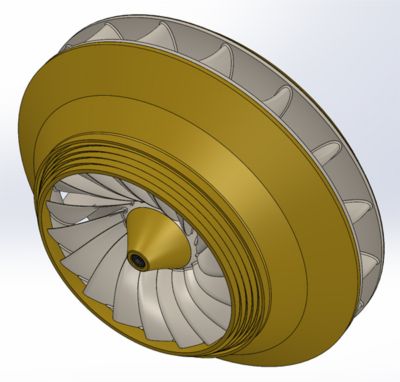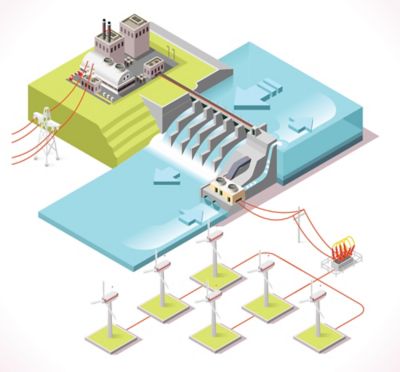ANSYS BLOG
July 25, 2019
Hydropower Turbine Designs that Ramp Up for Peak Energy Demands
Hydropower is one of the oldest sources of renewable energy. Though water turbine designs have evolved from the watermills of the past, one thing remains true. Hydropower is extremely reliable, which is why it continues to be an excellent source of baseload energy in many communities.
Recently, hydropower has been used as a source for peak energy and energy storage.Engineers can pump water uphill, during times of low energy demand, so potential energy is stored for later use.
HydroFlex Francis turbine runner
Or, engineers can reduce, or cut, the flow of water from the reservoir to the turbine — effectively turning it on, or off, a few times a day.
However, water turbine designs are not optimized for the transient states mentioned above, they are designed for continuous use. This is why HydroFlex is developing water turbines that operate efficiently at different flow rates and under variable dynamic loads. This capability will accommodate peak demand for energy and complement power generated from other energy sources.
New Water Turbine Designs Can Ramp Up Hydropower for Peak Loads
Hydropower is more reliable than other green energy sources.
With new turbines, hydropower can become an important part of the peak energy mix.
Solar and wind farms can be easily turned on or off, but they are dependent on the weather and time of day. Therefore, they may not be able to handle peak demands on a day-to-day basis — unless they are augmented by complicated energy storage systems. On the other hand, a reservoir acts as energy storage, as long as it exists there is predictable hydropower.
“HydroFlex’s designs can start and stop a turbine 30 times a day,” says Ole Gunnar Dahlhaug, professor at the Norwegian University of Science and Technology. “This is huge. Traditional turbines can maybe turn on, or off, one to three times a day. If a traditional turbine turned on or off 30 times a day, its fatigue loads would severely reduce its service life.”
How Traditional Water Turbine Designs Differ from HydroFlex Designs
Theoretically, hydropower can ramp up in a matter of seconds or minutes. As a point of comparison, coal power plants, with large turbines, can take hours, even days, to ramp up.
This benefit translates to an interesting design challenge for HydroFlex because quick changes and variability put additional loads on the equipment. That is why water turbines are typically designed for constant, stable use.
Turbulence and pressure changes in the water flow will increase the fatigue experienced by the turbine.
Changes in the water flow cause unsteady loads and high-pressure fluctuations, especially when moving from no flow to high flow.
“If the turbine blades are not designed for the turbulence and pressure fluctuations, then they will experience a lot of fatigue,” says Dahlhaug. “Because you are changing the operations many times, every change and variation causes more fatigue, further reducing the life of the turbine.”
Unlike traditional hydropower turbines, HydroFlex’s designs mitigate the turbulence and pressure fluctuations caused by changing flow rates. As a result. its designs weather the fatigue created by these forces better than traditional turbines.
How HydroFlex Optimizes its Water Turbine Designs
To create water turbines that can survive flow fluctuations, HydroFlex iterates its designs using Ansys Pervasive Engineering Simulation.
The simulations were run with the help of Ken-Robert Jakobsen, a senior technical consultant at EDRMedeso, an Ansys Channel Partner.
Modal acoustics simulation of the turbine
“We use Ansys CFX to model the fluid flow and Ansys Mechanical to check the turbine’s structural integrity,” says Jakobsen. “Then, we used Ansys OptiSlang to create a parametric optimization analysis that combines the mechanical and fluid models into one multiphysics simulation.”
Once the simulations are complete, and design engineers settle on a new optimal turbine, HydroFlex tests the model in a lab to verify its results. Once HydroFlex is satisfied with the turbine design, it will be able to handle frequent changes to the water flow. The turbine’s ability to handle variable flows enables a hydropower plant to operate based on peak and baseline power demands.
Ansys Channel partners offer engineers access to Ansys software with value-added service and support. To find a Channel partner near you, visit: Ansys Channel Partner Program.
Are you a professor with an interest in Ansys software? Learn more about the Ansys Academic Program.



